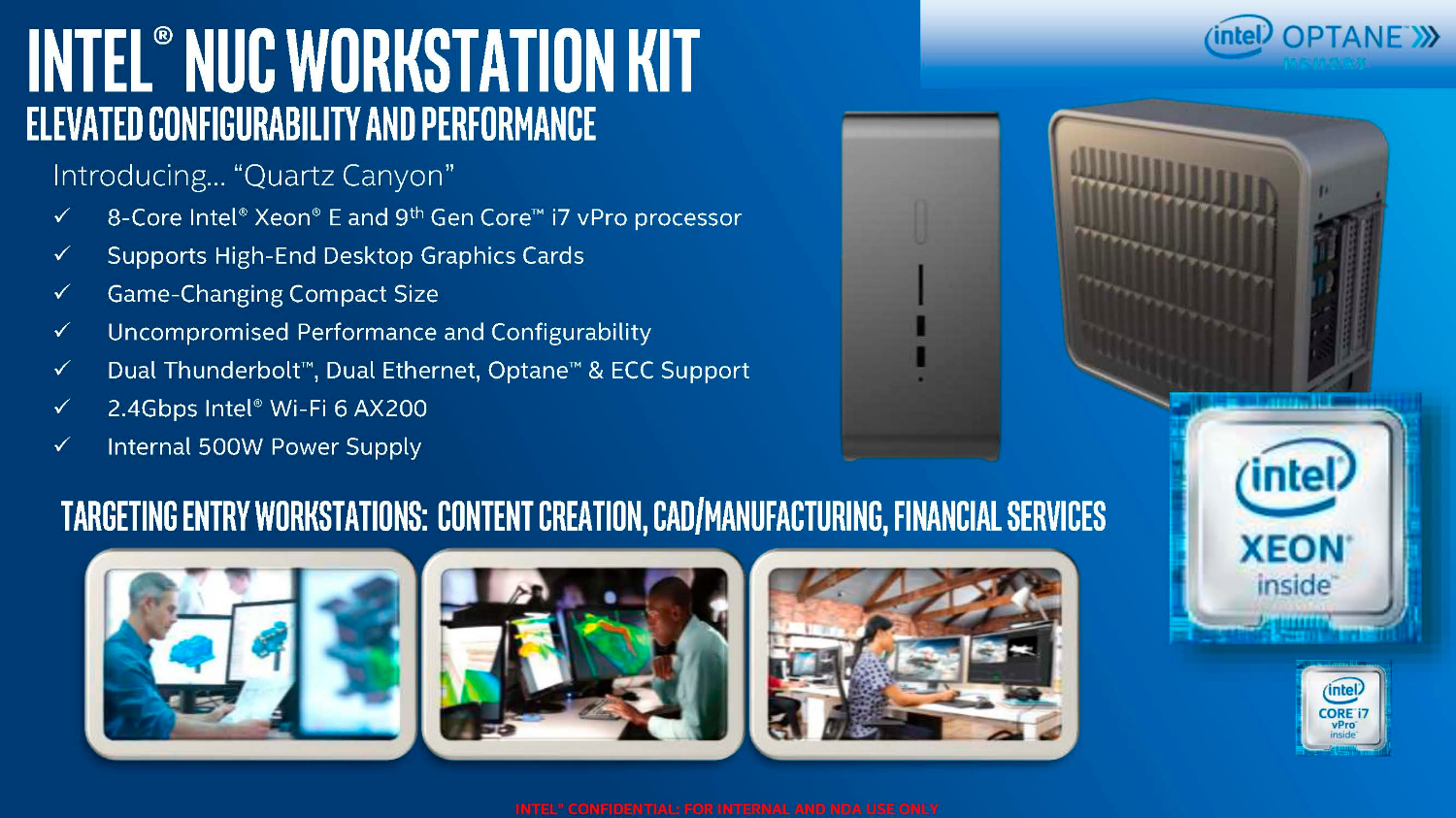An Intel product brochure, hosted at IT provider Softline's Russian website, seemingly reveals the chipmaker's upcoming Quartz Canyon NUC (next unit of computing) that targets workstation users, content creators, CAD professionals and business users.
By the images alone, the Quartz Canyon looks bigger than the NUCs we're accustomed to, which makes sense, since it'll reportedly feature support for one discrete graphics card.
On the processor side, Intel will allegedly offer the Quartz Canyon with an octa-core Xeon E chip or 9th Generation Core i7 vPro chip. Although the listing didn't specify the processor's exact model, we can think of a few candidates that fit the description:
| Model | Cores / Threads | Base / Boost (GHz) | Cache (MB) | TDP (W) |
| Intel Xeon E-2288G | 8 / 16 | 3.7 / 5.0 | 16 | 95 |
| Intel Xeon E-2278G | 8 / 16 | 3.4 / 5.0 | 16 | 80 |
| Intel Xeon E-2278GE | 8 / 16 | 3.3 / 4.7 | 16 | 80 |
| Intel Xeon E-2278GEL | 8 / 16 | 2.0 / 3.9 | 16 | 35 |
| Intel Xeon E-2286M | 8 / 16 | 2.5 / 5.0 | 16 | 45 |
| Intel Core i7-9700K | 8 / 8 | 3.6 / 4.9 | 12 | 95 |
| Intel Core i7-9700 | 8 / 8 | 3.0 / 4.7 | 12 | 65 |
| Intel Core i7-9700T | 8 / 8 | 2.0 / 4.3 | 12 | 35 |
If we look at the Xeon E family first, there are five chips that come with eight cores and 16 threads. The Xeon E-2288G, which is rated with a 95W TDP (thermal design power), is the highest-end part. It comes with a 3.7 GHz base clock and 5 GHz boost clock. The Xeon E-2278G holds the second position with a 3.4 GHz base clock and 5 GHz boost clock. For comparison, on the mainstream side the i7-9700K, i7-9700 and i7-9700T are the only 9th-Generation Core i7 chips that come with eight cores. The i7-9700K is the fastest of the trio.
The Quartz Canyon NUC will support EEC (error-correcting code) DDR4 memory modules and Intel Optane drives. The device also has dual Thunderbolt and Ethernet ports, plus an Intel Wi-Fi 6 AX200 adapter onboard that provides a wireless connection to the Internet with a maximum speed of 2.4 Gbps. Quartz Canyon has a 500W internal power supply.
The leaked brochure doesn't mention when the Quartz Canyon NUC will be available. But since the document is dated April 24, we don't expect to see the NUC until perhaps the last quarter of 2019 or early 2020.
Get Tom's Hardware's best news and in-depth reviews, straight to your inbox.

Zhiye Liu is a news editor, memory reviewer, and SSD tester at Tom’s Hardware. Although he loves everything that’s hardware, he has a soft spot for CPUs, GPUs, and RAM.
-
bit_user ReplyBy the images alone, the Quartz Canyon looks bigger than the NUCs we're accustomed to, which makes sense, since it'll reportedly feature support for one discrete graphics card.
This really stretches the definition of a NUC.
NUCs have always been small form-factor computers built around laptop SoCs. This is basically just an Intel-branded PC.
I guess they're just desperate to sell more high-margin products, these days. -
TCA_ChinChin Would be interesting for SFF community if the same chassis could also support mainstream Intel core series processors along with the supposed 1 discrete graphics card. Definitely outside the traditional definition of a NUC, but still quite SFF compared to many others on the market.Reply -
bit_user Reply
To be honest, I'm actually less concerned over whether it's strictly a NUC, and more interested that Intel is dipping a toe in the PC/workstation market.TCA_ChinChin said:Definitely outside the traditional definition of a NUC, but still quite SFF compared to many others on the market.
Recall that they got out of the motherboard market, about 5 years ago. So, this is an interesting change in direction. We'll see if it marks a trend, or if it's really about them trying to find more short-term revenue wherever they can.
